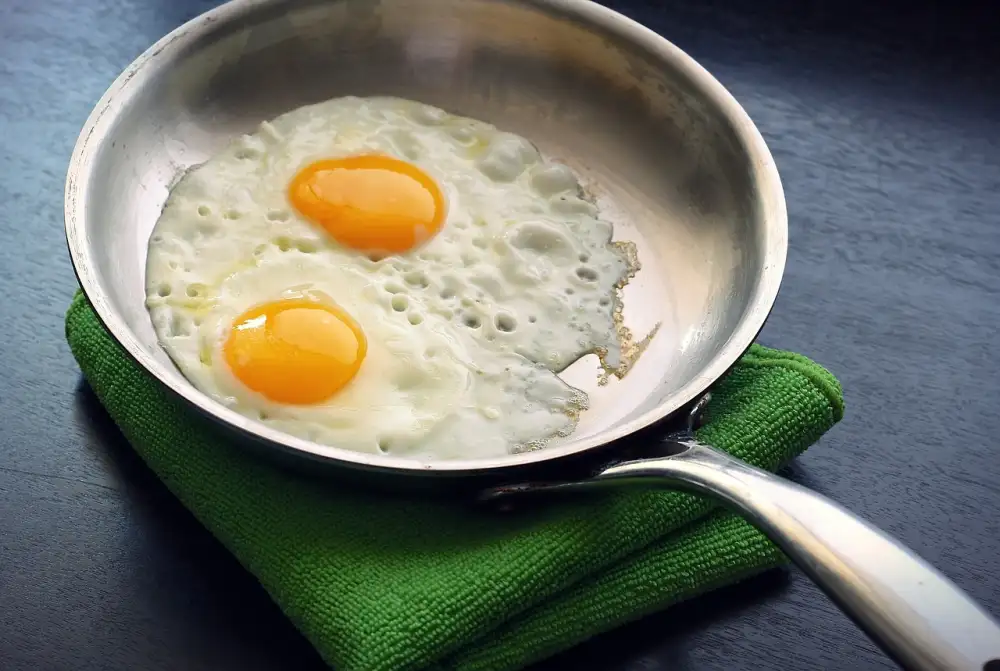Master the Art of Cleaning a Cast Iron Skillet: Expert Tips for Home Cooks

- Gather necessary supplies: kosher salt, a soft sponge or brush, dish soap, paper towels, and a clean cloth.
- Allow the skillet to cool down before cleaning to avoid burns or warping.
- Sprinkle kosher salt on the skillet's surface to act as a gentle abrasive.
- Use a soft sponge or brush to scrub the salt in circular motions, removing food residue.
- Rinse the skillet under warm water, avoiding the use of harsh soap that can strip the skillet's seasoning.
- If needed, use a small amount of mild dish soap to remove stubborn residues.
- Dry the skillet thoroughly using paper towels to prevent rusting.
- Place the skillet on a stove burner on low heat to ensure complete drying.
- Once dry, apply a thin layer of oil to the skillet's surface to maintain its seasoning.
- Store the skillet in a dry place to prevent moisture buildup and maintain its quality.
Gather necessary supplies: kosher salt, a soft sponge or brush, dish soap, paper towels, and a clean cloth.
To master the art of cleaning a cast iron skillet, it's essential to gather the necessary supplies beforehand. You will need kosher salt, which acts as a gentle abrasive, a soft sponge or brush for scrubbing, dish soap for tough residues, paper towels for drying, and a clean cloth for applying oil later on. Having these items ready will ensure a smooth and effective cleaning process for your cast iron skillet.
Allow the skillet to cool down before cleaning to avoid burns or warping.
Before diving into the cleaning process, it's crucial to allow your cast iron skillet to cool down completely. This step is essential to prevent burns and avoid the risk of warping the skillet. Cast iron retains heat exceptionally well, so giving it time to cool ensures a safe cleaning experience and helps maintain the skillet's integrity for long-term use. Wait until the skillet is at a safe temperature before proceeding with the cleaning steps to protect both yourself and your cookware.
Sprinkle kosher salt on the skillet's surface to act as a gentle abrasive.
To effectively clean a cast iron skillet, start by sprinkling kosher salt on the skillet's surface. The coarse texture of the salt acts as a gentle abrasive that helps to loosen stuck-on food particles without damaging the skillet's seasoning. This method is particularly useful for removing stubborn residues while preserving the skillet's non-stick surface. By gently scrubbing the salt in circular motions with a soft sponge or brush, you can ensure thorough cleaning without compromising the integrity of your cast iron cookware.
Use a soft sponge or brush to scrub the salt in circular motions, removing food residue.
To effectively clean a cast iron skillet, use a soft sponge or brush to scrub kosher salt in circular motions on the surface. The salt acts as a gentle abrasive, helping to loosen and remove food residue without damaging the skillet's seasoning. This method is safe and efficient in maintaining the skillet's quality while ensuring that it remains in optimal cooking condition for years to come.
Rinse the skillet under warm water, avoiding the use of harsh soap that can strip the skillet's seasoning.
After scrubbing the skillet with kosher salt, it's time to rinse off any remaining residue. Rinse the skillet under warm water, avoiding harsh soap that can damage the seasoning. The gentle abrasive action of the salt should have loosened most of the stuck-on food particles, allowing you to easily wash them away. Be sure to use only warm water and avoid using soap unless absolutely necessary to preserve the skillet's well-developed seasoning.
If needed, use a small amount of mild dish soap to remove stubborn residues.
If you encounter stubborn residues that the kosher salt and scrubbing didn't fully remove, it's okay to use a small amount of mild dish soap. However, be cautious as harsh soaps can strip the skillet's seasoning. Opt for a gentle dish soap and only use it sparingly to preserve the skillet's natural non-stick surface. Remember to rinse the skillet thoroughly after using soap to ensure no residue is left behind.
Dry the skillet thoroughly using paper towels to prevent rusting.
After rinsing the skillet under warm water, it is crucial to dry it thoroughly to prevent rusting. Use paper towels to wipe off any remaining moisture on the surface. Make sure to pay extra attention to the handle and any crevices where water might accumulate. Any lingering moisture can lead to rust formation, which can damage the skillet over time. Proper drying also helps maintain the seasoning of the cast iron, ensuring its longevity and performance in your cooking endeavors.
Place the skillet on a stove burner on low heat to ensure complete drying.
After drying the skillet thoroughly with paper towels, it's important to ensure complete drying to prevent any moisture from causing rust. To achieve this, place the skillet on a stove burner on low heat for a few minutes. The gentle heat will help evaporate any remaining water droplets, leaving the skillet completely dry. This step is crucial in maintaining the quality of your cast iron skillet and preventing any potential rusting issues that may arise from trapped moisture.
Once dry, apply a thin layer of oil to the skillet's surface to maintain its seasoning.
Once the cast iron skillet is thoroughly dry, it is essential to apply a thin layer of oil to maintain its seasoning. The oil creates a protective barrier that helps prevent rust and maintains the skillet's non-stick surface. You can use any high smoke point oil such as vegetable oil or flaxseed oil for this purpose. Simply apply a small amount of oil to a paper towel and rub it all over the skillet, including the cooking surface, handle, and exterior. This step will help keep your cast iron skillet in top condition for many years of use.
Store the skillet in a dry place to prevent moisture buildup and maintain its quality.
To maintain the quality of your cast iron skillet, it is crucial to store it in a dry place. Moisture can lead to rusting and deterioration of the skillet's seasoning. Store the skillet in a cool, dry place away from any sources of moisture, such as sinks or dishwashers. You can also place a paper towel inside the skillet to absorb any excess moisture and prevent rust formation. By storing your cast iron skillet properly, you can ensure its longevity and cooking performance for years to come.
Published: 06. 05. 2024
Category: Home



